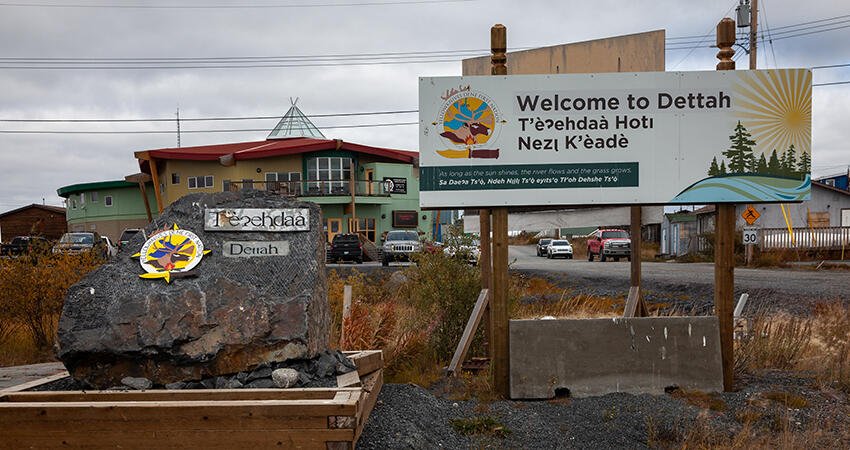
Dettah, Northwest Territories, Canada - 9/12/2018: Photo of 'Welcome to Dettah' sign of the Yellowknives Dene First Nation in Canada
(H.J. Herrera/Shutterstock)
Transforming Housing for Better Health Through Community Engagement
- Title:
-
Sekuwe (My House): building health equity through Dene First Nations housing designs
- Author:
-
Linda Larcombe, Lancelot Coar, Matthew Singer, Lizette Denechezhe, Evan Yassie, Tony Powderhorn, Joe Antsanen, Kathi Avery Kinew, and Pamela Orr
- Source:
- Publication Date:
-
2020
The Truth and Reconciliation Commission of Canada found that the Dene people, among other Indigenous groups, experienced cultural genocide through policies that separated them from their lands, resources, families, languages, and cultures. This has led to social inequities, including inadequate housing. And research shows poor-housing quality, overcrowding, and lack of community support can exacerbate stress, anxiety, and other mental, physical, and cultural health issues.
This Dene healthy housing research is a continuing partnership between two Dene First Nation communities, the University of Manitoba, and a provincial First Nation nongovernment organization aimed at designing healthier housing that reflects Dene culture, lifestyle, and values to address the social and biological determinants of health in northern Manitoba. This project engaged the creative energies of community members to create and articulate Dene healthy housing designs, preparing them for funding interventions. Together, they codeveloped methods and networks to reframe housing as a social determinant of health and an important factor in social justice. The study’s interventions included the following:
- Housing Week events: Project partners engaged the Dene communities through feasts, workshops, meetings, contests, and craft nights to gather their ideas on healthy housing.
- Exchange program: Dene students visited the University of Manitoba to collaborate with architecture students on initial housing designs.
- Community visits: Architecture students visited the Dene communities to learn about their history, culture, and current housing and health realities.
- Training: Dene students were trained to document Housing Week events using digital cameras and video recorders.
- Feedback and finalization: The final housing designs were presented to the Dene communities for feedback, which was then incorporated into the final designs.
Their research highlighted five themes that were incorporated into community partners housing programming: material identity, cultural design integration, energy independence, food security, and long-term maintenance. The effort shows the value of community centered research and design to improving culturally sensitive housing to promote health outcomes.
Key findings
- Material identity: Many Dene community members feel a deep connection to their history and regional identity through the materials used in housing. They expressed a preference for natural, local materials like unpainted wood over modern materials like drywall, which they find “cold” and “impersonal.” Using local materials not only honors cultural traditions but also creates local jobs and strengthens the community’s connection to the land.
- Cultural design integration: Community members expressed a need for housing designs that support traditional Dene practices like caribou hunting, butchering, craft making, and large gatherings. Current homes don’t accommodate these activities, often leading to unhealthy conditions such as excess moisture and the presence of animal remains in living spaces. The project recommends designing homes with flexible spaces and appropriate utilities to support these cultural practices, ensuring the transfer of history, skills, and cultural identity within the Dene communities.
- Energy independence: Homes in northern Manitoba rely heavily on diesel furnaces, which often break down from a lack of local expertise, creating dangerous situations in winter. This reliance has also disconnected the community from traditional wood-gathering practices that offer energy independence and employment. To address these issues, student designs propose installing high-efficiency wood stoves as a backup and optimizing home designs for better energy efficiency through passive solar gain and improved insulation.
- Food security: Food security in remote northern reserves is closely tied to housing design. Current homes lack spaces for traditional food production activities like hunting, fishing, and vegetable gardening, leading to reliance on unhealthy and expensive imported foods. Student projects propose integrating areas for butchering, meat preparation, and greenhouses into home designs to support traditional practices, improve food security, and promote healthier diets.
- Long-term maintenance: Adult community members primarily voiced concerns about inadequate housing maintenance, where minor issues often escalate into significant problems affecting health and safety. Student projects emphasized designing homes that allow for ongoing maintenance by trained community members. Additionally, involving householders in the design and construction process can help them identify and address maintenance issues through education and preventative care.
Policy implications
- Healthy housing promotes social inclusion, networks, and opportunities, but achieving meaningful results requires community input and collaboration. Housing issues are complex and require local leadership and skill building for sustainable solutions.
- This study highlights the importance of merging traditional knowledge with modern building practices to create housing that reflects Dene cultural, environmental, and spiritual values.
Researchers and advocates for social justice can use these housing designs and the collaborative process as a model for building culturally tailored homes that promote healthier living conditions.


